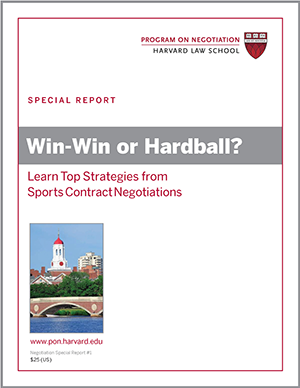
Breaking an Unproductive Competitive Cycle with Win-Win Negotiation Strategies
Negotiators seeking to break through the mythical fixed-pie mindset can try the following three proven win-win negotiation strategies suggested by Max Bazerman in a previous issue of Negotiation Briefings, for finding mutually beneficial tradeoffs.
Win-Win Negotiation Strategies Used to Pass Bipartisan Legislation in the US Senate
Back in 2010, the U.S. Senate’s struggle to pass truly bipartisan financial reform revealed ways negotiators can overcome suspicion and enhance cooperation.
Initially, the partnership seemed promising. Senator Christopher Dodd, a Connecticut Democratic, hoped to cap his 29-year congressional career with a bipartisan financial regulation bill. Senator Bob Corker, a freshman Republican from Tennessee and member of Dodd’s Senate Banking Committee, wanted to make a splash in his new job.
After Dodd reached an impasse with Republican Senator Richard Shelby of Alabama, he and Corker teamed up in February 2010 with the goal of overcoming the us-versus-them mentality that was dominating the Senate, as reported by John Harwood in the New York Times.
Both political parties were eager to demonstrate to voters that the era of taxpayer-funded bailouts of corporations and banks had ended.
Moreover, a House finance reform bill had already passed. As negotiations began, Corker was cheered by how well his staff and Dodd’s worked together on the complex issue despite their ideological differences.
Nonetheless, both sides faced heat from their parties for allegedly selling out their principles.
Despite a month of successful negotiations between their staffs, Corker concluded that there was little hope his fellow Republicans would support the bipartisan proposal.
Win-Win Negotiation and Saving a Relationship?
The partnership ended.
“If it’s just he and I agreeing,” Dodd told the Times, referring to himself and Corker, “the compromise isn’t worth much.”
Dodd turned his attention to putting together a bill that Democrats were more likely to support—and that Republicans would likely condemn.
As for Corker, he concluded that Washington culture is “all about winning” at the expense of pragmatism.
“What you’re trying to do now was routine 15 to 20 years ago,” Dodd told Corker during their negotiations.
Clearly, times have changed.
Congressional politics has gotten increasingly divisive, to the point that negotiating with someone across the aisle is often viewed by fellow party members and voters alike as a betrayal of one’s ideological principles.
The inability or unwillingness of the two parties to cooperate on the major issues facing the nation offers lessons to negotiators coping with relentless pressure to compete rather than collaborate.
We highlight the Senate’s efforts to negotiate a financial regulation bill as an example of both the pitfalls of dysfunctional competition and the ways it can be overcome.
An increasingly partisan public U.S. voter may say they want greater cooperation in Washington, but voters themselves are largely to blame for the inability of the two major parties to forge consensus, some experts say.
“People will tell you they don’t like partisanship,”
Finding the Zone of Possible Agreement with Your Counterpart
Emory University political scientist Alan Abramowitz told the Associated Press, “but their solution is ‘The other side should give in to us.’”
By voting out politicians who cooperate with the rival party and supporting the most ideologically pure, activists on the left and on the right pushed the two parties to the fringes, writes Charles Babington in a May 2010 Associated Press article.
Democratic voters in Pennsylvania, for example, ousted Arlen Specter, a well-known centrist who had switched parties; and Arkansas Democrats, backed by MoveOn.org, forced another moderate, Blanche Lincoln, into a tough primary runoff. (She survived.)
Some in Congress responded to this trend by curbing their bipartisan initiatives, as seen in Senator John McCain’s changing stance on immigration reform in the midst of a tough reelection battle in Arizona.
In their book You Can’t Enlarge the Pie: Six Barriers to Effective Government (Basic Books, 2001), Max H. Bazerman, Jonathan Baron, and Katherine Shonk also attribute dysfunctional competition in Washington to the power of special interest groups to sway politicians’ dealmaking and voting behavior through campaign donations and intense lobbying efforts.
The Myth of a Fixed Pie
After Dodd and Corker abandoned their bipartisan effort, the Democrats put together a bill that was defeated twice on the Senate floor by the Republicans, who put forth their own bill.
This push-pull occurred despite the fact that the two proposals shared broad areas of agreement, as reported in the New York Times.
Both provided for the liquidation of troubled financial companies, though they differed in how such efforts should be funded.
And both called for the creation of a consumer protection agency aimed at ending predatory lending practices, though they disagreed on which types of companies should be regulated.
Despite these similarities, the Democrats and Republicans disparaged each other’s bills and accused each other of being obstructionist.
Even if you prefer partisans to centrists within your own political party, you likely support the goal of reducing the type of dysfunctional competition that has thrived on Capitol Hill in recent years.
In an NBC / Wall Street Journal poll at the time, 93% of those surveyed agreed that there was too much fighting between the two major parties.
How Can Polarized Negotiators Achieve Win-Win Negotiation?
In part by addressing a cognitive bias that tends to drive them apart: the myth of a fixed pie, or the false assumption that most competitive situations in which they find themselves are purely win-lose.
Negotiators often fail to look for tradeoffs that could enlarge the pool of resources to be distributed, note Bazerman, Baron, and Shonk.
Rather than working together to increase the size of the overall pie, negotiators end up haggling over a small pie, reducing the chance of achieving win-win negotiation.
The assumption of a fixed pie triggers competitive behavior that bypasses opportunities for collaboration and leaves parties entrenched in an impasse.
Finding Tradeoffs at the Bargaining Table
On April 28, 2010, perhaps fearful of appearing soft on Wall Street, Senate Republicans agreed to allow the Democrats’ bill to be debated on the Senate floor.
On May 5, in a 93-5 vote, the Senate approved an amendment proposed by Senator Shelby that dropped a $50 billion fund to cover the cost of closing failing firms, which Shelby and other Republicans argued would have encouraged reckless behavior.
Democrats supported the amendment to curry much-needed Republican support for the legislation, the Washington Post reports. On May 20, the Senate voted 59-39 to pass the financial regulatory bill.
Four Republicans voted with the Democratic majority, and two Democrats opposed the bill, saying it was too weak.
Given the similarity of the bill to the one passed earlier by the House, Congress was expected to pass the new regulation within a matter of weeks.
As indicated by the final vote, the Senate’s finance bill was hardly bipartisan, but it did reflect greater cooperation between Democrats and Republicans than the health care bill signed into law in March.
These strategies may or may not have been used in the Senate’s battle over financial regulation.
In June 2017, President Donald Trump pledged to repeal Dodd-Frank and replace it with the Financial CHOICE Act.
Read more: Dodd-Frank Financial Regulatory Reform Bill https://www.investopedia.com/terms/d/dodd-frank-financial-regulatory-reform-bill.asp#ixzz4xwjuxDa7
Follow us: Investopedia on Facebook
1. Share information.
Negotiators often hesitate to share information about their interests, for fear the other side will take advantage of such disclosures.
In fact, the value created by sharing information typically outweighs the risks of exposure (see also, The Anchoring Effect – What to Share in Negotiation).
2. Ask questions.
Don’t make the common mistake of viewing negotiation primarily as a means of influencing the party across the table, lest you do more talking than listening.
By probing your counterpart about the interests behind her positions, you will gain information that can help you develop novel tradeoffs (Reservation Point Negotiation: Reach Negotiated Agreements by Asking the Right Questions).
3. Make multiple offers.
Most of us, senators included, tend to put one offer on the table at a time. What have we learned if it’s rejected? Very little.
By contrast, if you present several different offers at the same time (a strategy we also recommend in our cover story), each of which is acceptable to you, you can discover what your counterpart cares about most—and where potential trades can be found—based on which one she prefers (see also, MESO Negotiation: The Benefits of Making Multiple Equivalent Simultaneous Offers in Negotiation).
Leave a comment below to share a story where you’ve used win-win negotiation.
Adapted from “Trapped in a Competitive Cycle? Learn from Congress’s Mistakes,” first published in the August 2010 issue of Negotiation.





